Diagenetic Origin of Bipyramidal Quartz and Hydrothermal Aragonites within the Upper Triassic Saline Succession of the Iberian Basin: Implications for Interpreting the Burial–Thermal Evolution of the Basin
Abstract
1. Introduction
2. Geological Setting
3. Materials and Methods
4. Results
4.1. Petrographic Analyses
4.2. Geochemical Analyses
4.3. Scanning Electron Microscope Analyses
4.4. Cathodoluminescence and Raman Spectra Analyses
5. Discussion
5.1. Relationship between Doubly Terminated Quartz Crystals, Evaporites, Organic Matter, and Silica Sources
5.2. Second Phase of Quartz Formation: Quartz Overgrowth
5.3. Relation of the Bipyramidal Quartz with the Aragonite Presence in the Keuper Facies
6. Conclusions
Author Contributions
Funding
Acknowledgments
Conflicts of Interest
References
- Herrero, M.J.; Marfil, R.; Escavy, J.I.; Scherer, M.; Arroyo, X.; Martín-Crespo, T.; López de Andrés, S. Hydrothermal activity within a sedimentary succession: Aragonites as indicators of Mesozoic Rifting (Iberian Basin, Spain). Int. Geol. Rev. 2020, 62, 94–112. [Google Scholar] [CrossRef]
- Chafetz, H.S.; Zhang, J. Authigenic Euhedral Megaquartz Crystals in a Quaternary Dolomite. J. Sediment. Pet. 1998, 68, 994–1000. [Google Scholar] [CrossRef]
- Winsborough, B.M.; Seeler, J.S.; Golubic, S.; Folk, R.L. Recent fresh-water lacustrine stromatolites, stromatolitic mats and oncoids from northeastern Mexico. In Phanerozoic Stromatolites II; Bertrand-Sarfati, J., Monty, C., Eds.; Kluwer Academic Publishers: Dordrecht, The Netherlands, 1994; pp. 71–100. [Google Scholar]
- Folk, R.L. Petrography and petrology of the Lower Ordovician Beekmantown carbonate rocks in the vicinity of State College. Ph.D. Thesis, Pennsylvania State University, Pennsylvania, PA, USA, 1952. [Google Scholar]
- Friedman, G.M.; Shukla, V. Significance of authigenic quartz euhedra after sulfates: Example from the Lockport Formation (Middle Silurian) of New York. J. Sediment. Res. 1980, 50, 1299–1304. [Google Scholar]
- Wilson, R.C.L. Silica diagenesis in Upper Jurassic limestones of Southern England. J. Sediment. Pet. 1966, 36, 1036–1049. [Google Scholar]
- Zenger, D.H. Definition of type Little Falls Dolostone (Late Cambrian), east-central New York. Am. Assoc. Pet. Geol. Bull. 1976, 60, 1570–1575. [Google Scholar]
- Scholle, P.A. A Color Illustrated Guide to: Constituents, Textures, Cements, and Porosities of Sandstones and Associated Rocks. Am. Assoc. Pet. Geol. 1979, 27, 201. [Google Scholar]
- Folk, R.L.; Pittman, J.S. Length-slow chalcedony: A new testament for vanished evaporites. J. Sediment. Pet. 1971, 41, 1045–1058. [Google Scholar]
- Friedman, G.M. Dissolution-collapse breccias and paleokarst resulting from dissolution of evaporite rocks, especially sulfates. Carbonates Evaporites 1997, 12, 53–63. [Google Scholar] [CrossRef]
- Milliken, K.L. The silicified evaporite syndrome—Two aspects of silicification history of former evaporite nodules from southern Kentucky and northern Tennessee. J. Sediment. Pet. 1979, 49, 245–256. [Google Scholar]
- Marfil, R. Estudio Petrogenético del Keuper en el sector meridional de la Cordillera Ibérica. Estudios Geológicos 1970, 24, 113–161. [Google Scholar]
- Calvo Rebollar, M. Minerales Y Minas De España. Volumen VIII: Cuarzo Y Otros Minerales De La Sílice; Fundación Gómez-Pardo: Madrid, Spain, 2016; p. 399. [Google Scholar]
- Knauth, L.P. Petrogenesis of chert. In Silica, Physical Behavior, Geochemistry and Materials Application; Heaney, P.J., Prewitt, C.T., Gibbs, G.V., Eds.; Mineralogical Society of America: Chantilly, VA, USA, 1994; Volume 29, pp. 233–258. [Google Scholar]
- Warren, J.K. Evaporites: A Geological Compendium; Springer: Berlin/Heidelberg, Germany, 2016; p. 1816. [Google Scholar]
- Scotford, D.M. A Test of Aluminum in Quartz as a Geothermometer. Am. Mineral. 1975, 60, 139–142. [Google Scholar]
- Bustillo, M.A. Silicification of Continental Carbonates. In Developments in Sedimentology; Alonso-Zarza, A.M., Tanner, L.H., Eds.; Elsevier: Amsterdam, The Netherlands, 2010; Volume 62, pp. 153–178. [Google Scholar]
- Goudie, A.; Calcrete, S.; Goudie, A.S. Chemical Sediments and Geomorphology; Goudie, A.S., Pye, K., Eds.; Academic Press: London, UK, 1983; pp. 93–131. [Google Scholar]
- Arche, A.; López-Gómez, J. Origin of the Permian-Triassic Iberian Basin, central-eastern Spain. Tectonophysics 1996, 266, 443–464. [Google Scholar] [CrossRef]
- Sopeña, A.; López-Gómez, J.; Arche, A.; Pérez-Arlucea, M.; Ramos, A.; Virgili, C.; Hernándo, S. Permian and Triassic rift basins of the Iberian Peninsula. In Triassic–Jurassic Rifting—Continental Breakup and the Origin of the Atlantic Ocean and Passive Margins; Manspeizer, W., Ed.; Elsevier: Amsterdam, The Netherlands, 1988; Volume 22B, pp. 757–786. [Google Scholar]
- Van Wees, J.D.; Arche, A.; Beijdorff, C.G.; López-Gómez, J.; Cloetingh, S. Temporal and spatial variations in tectonic subsidence in the Iberian Basin (eastern Spain): Inferences from automated forward modelling of high-resolution stratigraphy (Permian–Mesozoic). Tectonophysics 1998, 300, 285–310. [Google Scholar] [CrossRef]
- Vargas, H.; Gaspar-Escribano, J.; López-Gómez, J.; Van Wees, J.D.; Cloetingh, S.; De la Horra, R.; Arche, A. A comparison of the Iberian and Ebro Basins during the Permian and Triassic, eastern Spain: A quantitative subsidence modelling approach. Tectonophysics 2009, 474, 160–183. [Google Scholar] [CrossRef]
- Salas, R.; Guimerà, J.; Mas, R.; Martín-Closas, C.; Meléndez, A.; Alonso, A. Evolution of the Mesozoic Central Iberian Rift System and its Cainozoic inversion (Iberian Chain). In Peri-Tethys Memoir 6: Peri-Tethyan Rift/Wrench Basins and Passive Margins; Ziegler, P.A., Cavazza, W., Robertson, A.H., Crasquin-Soleau, F., Eds.; Muséum National Histoire Naturelle: Paris, France, 2001; pp. 145–185. [Google Scholar]
- Sopeña, A.; Sánchez-Moya, Y. Tectonic systems tract and depositional architecture of the western border of the Triassic Iberian Trough (central Spain). Sediment. Geol. 1997, 113, 245–267. [Google Scholar] [CrossRef]
- Sánchez-Moya, Y.; Sopeña, A. El rift Mesozoico Ibérico. In Geología de España; Vera, J.A., Ed.; SGE-IGME: Madrid, Spain, 2004; pp. 484–522. [Google Scholar]
- Rosembaum, G.; Lister, G.S.; Duboz, C. Relative motions of Africa, Iberia and Europe during Alpine orogeny. Tectonophysics 2002, 359, 117–129. [Google Scholar] [CrossRef]
- López-Gómez, J.; Alonso-Azcárate, J.; Arche, A.; Arribas, J.; Fernández Barrenechea, J.; Borruel-Abadía, V.; Bourquin, S.; Cadenas, P.; Cuevas, J.; De la Horra, R.; et al. Permian-Triassic Rifting Stage. In The Geology of Iberia: A Geodynamic Approach; Quesada, C., Oliveira, T., Eds.; Springer: Berlin/Heidelberg, Germany, 2019; Volume 3, pp. 29–112. [Google Scholar]
- De Vicente, G.; Vegas, R.; Muñoz-Martín, A.; Van Wees, J.D.; Casas-Sainz, A.M.; Sopeña, A.; Sánchez-Moya, Y.; Arche, A.; López-Gómez, J.; Olaiz, A.; et al. Oblique strain partitioning and transpression on an inverted rift: The Castilian Branch of the Iberian Chain. Tectonophysics 2009, 470, 224–242. [Google Scholar] [CrossRef]
- Murphy, J.B.; Nance, R.D.; Cawood, P.A. Contrasting modes of supercontinent formation and the conundrum of Pangea. Gondwana Res. 2009, 15, 408–420. [Google Scholar] [CrossRef]
- Ziegler, P.A.; Stamplfli, G.M. Late Paleozoic-early Mesozoic plate boundary reorganization, collapse of the variscan orogeny and opening of neotethys. In Permian Continental Deposits of Europe and other Areas. Regional Reports and Correlations; Cassinis, G., Ed.; Museo Civico Science Naturali: Brescia, Italy, 2001; Volume 25, pp. 17–34. [Google Scholar]
- López-Gómez, J.; Arche, A.; Pérez-López, A. Permian and Triassic. In The Geology of Spain; Gibbons, W., Moreno, T., Eds.; The Geological Society: London, UK, 2002; pp. 185–212. [Google Scholar]
- Sopeña, A.; Gutiérrez-Marco, J.C.; Sánchez-Moya, Y.; Gómez, J.J.; Mas, J.R.; García, A.; Lago, M. Cordillera Ibérica y Costero Catalana. In Geología de España; Vera, J.A., Ed.; SGE-IGME: Madrid, Spain, 2004; pp. 465–527. [Google Scholar]
- Ortí, F.; Pérez-López, A.; Salvany, J.M. Triassic evaporites of Iberia: Sedimentological and palaeogeographical implications for the western Neotethys evolution during the Middle Triassic-Earliest Jurasic. Palaeogeogr. Palaeoclimatol. Palaeoecol. 2017, 471, 157–180. [Google Scholar] [CrossRef]
- Suarez Alba, J. La Mancha Triassic and Lower Lias stratigraphy, a well log interpretation. J. Iber. Geol. 2007, 33, 55–78. [Google Scholar]
- Arche, A.; López-Gómez, J.; García-Hidalgo, J.F. Control climático, tectónico y eustático en depósitos del Carniense (Triásico Superior) del SE de la Península Ibérica. J. Iber. Geol. 2002, 28, 13–30. [Google Scholar]
- Ortí, F.; García-Veigas, J.; Rosell Ortiz, L.; Jurado, M.J.; Utrilla, R. Formaciones salinas de las cuencas triásicas en la Península Ibérica: Caracterización petrológica y geoquímica. Cuadernos De Geología Ibérica 1996, 20, 13–35. [Google Scholar]
- Escavy, J.I.; Herrero, M.J. The use of location-allocation techniques for exploration targeting of high place-value industrial minerals: A market-based prospectivity study of the Spanish gypsum resources. Ore Geol. Rev. 2013, 53, 504–516. [Google Scholar] [CrossRef]
- Escavy, J.I.; Herrero, M.J.; Arribas, M.E. Gypsum resources of Spain: Temporal and spatial distribution. Ore Geol. Rev. 2012, 49, 72–84. [Google Scholar] [CrossRef]
- Goy, A.; Martínez, G.; Pérez-Valera, F.; Pérez-Valera, J.A.; Trigueros-Ramos, L.M. Nuevos hallazgos de Cefalópodos (Ammonoideos y Nautiloideos) del Ladiniense Inferior en el sector oriental de las Cordillera Béticas. Boletín de la Real Sociedad Española de Historia Natural 1996, 125, 311–314. [Google Scholar]
- Lago, M.; Dumitrescu, R.; Bastida, J.; Arranz, E.; Gil-Imaz, A.; Pocovi, A.; Lapuente, M.P.; Vaquer, R. Características de los magmatismos alcalino y subalcalino, pre-Hettangiense, del borde SE de la Cordillera Ibérica. Cuadernos De Geología Ibérica 1994, 20, 159–181. [Google Scholar]
- Chun, F.H. Quantitative interpretation of X-ray diffraction patterns of mixtures. III. simultaneous determination of a set of reference intensities. J. Appl. Chrystallogr. 1975, 8, 17–19. [Google Scholar] [CrossRef]
- Zinkernagel, U. Cathodoluminescence of quartz and its application to sandstone petrology. Contrib. Sedimentol. 1978, 8, 1–69. [Google Scholar]
- Matter, A.; Ramseyer, K. Cathodoluminescence Microscopy as A Tool for Provenance Studies of Sandstones. In Provenance of Arenites; Zuffa, G.G., Ed.; Reidel: Boston, MA, USA, 1985; pp. 191–211. [Google Scholar]
- El Tabakh, M.; Grey, K.; Pirajno, F.; Schreiber, B.C. Pseudomorphs after evaporitic minerals interbedded with 2.2 Ga stromatolites of the Yerrida basin, Western Australia: Origin and significance. Geology 1999, 27, 871–874. [Google Scholar] [CrossRef]
- Kingma, K.J.; Hemley, R.J. Raman spectroscopic study of microcrystalline silica. Am. Miner. 1994, 79, 269–273. [Google Scholar]
- Rodgers, K.A.; Cressey, G. The occurrence, detection and significance of moganite (SiO2) among some silica sinters. Miner. Mag. 2001, 65, 157–167. [Google Scholar] [CrossRef]
- Del Olmo, P.; Olivé, A.; Gutiérrez, M.; Aguilar, M.J.; Leal, M.C.; Portero, J.M. Hoja geológica 438 (Paniza). In Mapa Geológico de España, E. 1:50.000; Segunda Serie I.G.M.E.: Madrid, Spain, 1983. [Google Scholar]
- Castaño, R.; Doval, M.; Marfil, R. Naturaleza, origen y distribución de los minerales de la arcilla en la cuenca Triásica (Keuper) del área de Valencia. Cuadernos de Geología Ibérica 1987, 11, 339–361. [Google Scholar]
- Miehe, G.; Graetsch, H.; Flörke, O.W. Crystal structure and growth fabric of length-fast chalcedony. Phys. Chem. Miner. 1984, 10, 197–199. [Google Scholar] [CrossRef]
- Sánchez-Moya, Y.; Herrero, M.J.; Sopeña, A. Strontium isotopes and sedimentology of a marine Triassic succesion (upper ladinian) of the westernmost Tethys, Spain. J. Iber. Geol. 2016, 42, 171–186. [Google Scholar]
- Palmer, S.E. Effect of Biodegradation and Water Washing On Crude Oil Composition. In Organic Geochemistry: Principles and applications; Engel, M.H., Macko, S.A., Eds.; Springer: Berlin/Heidelberg, Germany, 1993; Volume 11, pp. 511–533. [Google Scholar]
- Siever, R. Silica solubility 0–200 °C and the diagenesis of siliceous sediments. J. Geol. 1962, 70, 127–150. [Google Scholar] [CrossRef]
- Mahran, T.M. Late Oligocene lacustrine deposition of the Sodmin Formation, Abu Hammad Basin, Red Sea, Egypt; sedimentology and factors controlling palustrine carbonates. J. Afr. Earth Sci. 1999, 29, 567–592. [Google Scholar] [CrossRef]
- De Wet, C.C.; J. F.; H. The Scots Bay Formation, Nova Scotia, a Jurassic carbonate lake with silica-rich hydrothermal springs. Sedimentology 1989, 36, 857–875. [Google Scholar] [CrossRef]
- Smith, A.M.; Mason, T.R. Pleistocene, multiple-growth, lacustrine oncoids from the Poacher’s Point Formation, Etosha Pan, northern Namibia. Sedimentology 1991, 38, 591–599. [Google Scholar] [CrossRef]
- Lago, M.; Arranz, E.; Gil, A.; Pocovi, A. Cordilleras Ibérica y Costero-Catalana; Magmatismo Asociado. In Geología de, España, Vera, J.A., Eds.; SGE-IGME: Madrid, Spain, 2004; p. 890. [Google Scholar]
- Maliva, R.G.; Siever, R. Nodular chert formation in carbonate rocks. J. Geol. 1989, 97, 421–433. [Google Scholar] [CrossRef]
- Williams, L.A.; Parks, G.; Crerar, D.A. Silica diagenesis, I. Solubility controls. J. Sediment. Pet. 1985, 55, 301–311. [Google Scholar]
- Williams, L.A.; Crerar, D.A. Silica diagenesis II. General mechanisms. J. Sediment. Pet. 1985, 55, 312–321. [Google Scholar]
- Alonso-Zarza, A.M.; Sánchez-Moya, Y.; Bustillo, M.A.; Sopeña, A.; Delgado, A. Silicification and dolomitization of anhydrite nodules in argillaceous terrestrial deposits: An example of meteoric-dominated diagenesis from the Triassic of central Spain. Sedimentology 2002, 49, 303–317. [Google Scholar] [CrossRef]
- Arbey, F. Les formes de la silice et l'identification des évaporites dans les formations silicifiées. Bulletin des Centres de Recherche, Exploration-Production Elf Aquitaine 1980, 4, 309–365. [Google Scholar]
- Hesse, R. Silica diagenesis: Origin of inorganic and replacement cherts. Earth-Sci. Rev. 1989, 26, 253–284. [Google Scholar] [CrossRef]
- Rimstidt, J.D.; Barnes, H.L. The kinetics of silica-water reactions. Geochimica et Cosmochimica Acta 1980, 44, 1683–1699. [Google Scholar] [CrossRef]
- Götze, J.; Plötze, M.; Tichomirowa, M.; Fuchs, H.; Pilot, J. Aluminium in quartz as an indicator of the temperature of formation of agate. Miner. Mag. 2001, 65, 407–413. [Google Scholar] [CrossRef]
- Ramseyer, K.; Baumann, J.; Matter, A.; Mullis, J. Cathodoluminescence colours of alpha-quartz. Miner. Mag. 1988, 52, 669–677. [Google Scholar] [CrossRef]
- Götze, J. Mineralogy, Geochemistry and cathodoluminescence of authigenic quartz from different sedimentary rocks. In Quartz: Deposits, Mineralogy and Analytics; Götze, J., Möckel, R., Eds.; Springer: Berlin/Heidelberg, Germany, 2012; pp. 287–306. [Google Scholar]
- Waugh, B. Formation of quartz overgrowths in Penrith Sandstone (Lower Permian) of northwest England as revealed by scanning electron microscopy. Sedimentology 1970, 14, 309–320. [Google Scholar] [CrossRef]
- French, M.W.; Worden, R.H.; Mariani, E.; Larese, R.E.; Mueller, R.R.; Kliewer, C.E. Microcrystalline Quartz Generation and the Preservation of Porosity in Sandstones: Evidence from the Upper Cretaceous of the Subhercynian Basin, Germany. J. Sediment. Res. 2012, 82, 422–434. [Google Scholar] [CrossRef]
- Wilkinson, M.; Haszeldine, R.S. Fibropus illite in oilfield sandstones—A nucleation kinetic theory of growth. Terra Nova 2002, 14, 56–60. [Google Scholar] [CrossRef]
- Worden, R.H.; Morad, S. Quartz cementation in oil field sandstones: A review of the key controversies. Spec. Publ. Int. Assoc. Sedimentol. 2000, 29, 1–20. [Google Scholar]
- Dennen, W.H.; Blackburn, W.H.; Quesada, A. Aluminium in quartz as a geothermometer. Contrib. Miner. Pet. 1970, 27, 32–42. [Google Scholar] [CrossRef]
- García Palacios, M.C.; Lucas, J.; De la Peña, J.A.; Marfil, R. La Cuenca Triásica de la Rama Castellana de la Cordillera Ibérica. I Petrografía y Mineralogía. Cuadernos de Geología Ibérica 1977, 4, 341–354. [Google Scholar]
- Lago, M.; Pocovi, A.; Bastida, J.; Arranz, E.; Vaquer, R.; Dumitrescu, R.; Gil-Imaz, A.; Lapuente, M.P. El magmatismo alcalino, hettangiense, en el dominio nor-oriental de la Placa Ibérica. Cuadernos de Geología Ibérica 1996, 20, 109–138. [Google Scholar]
- Dercourt, J.; Gaetani, M.; Vrielynck, B.; Barrier, E.; Biju-Duval, B.; Brunet, M.F.; Cadet, J.P.; Crasquin, S.; Sandulescu, M. Atlas or Peri-Tethys. Paleeogeographical Maps; Commission for the Geological Map of the World: Paris, France, 2000; p. 268. [Google Scholar]
- Tornos, F.; Spiro, B.F. The Geology and Isotope Geochemistry of the Talc Deposits of Puebla de Lillo (Cantabrian Zone, Northern Spain). Econ. Geol. 2000, 95, 1277–1296. [Google Scholar] [CrossRef]
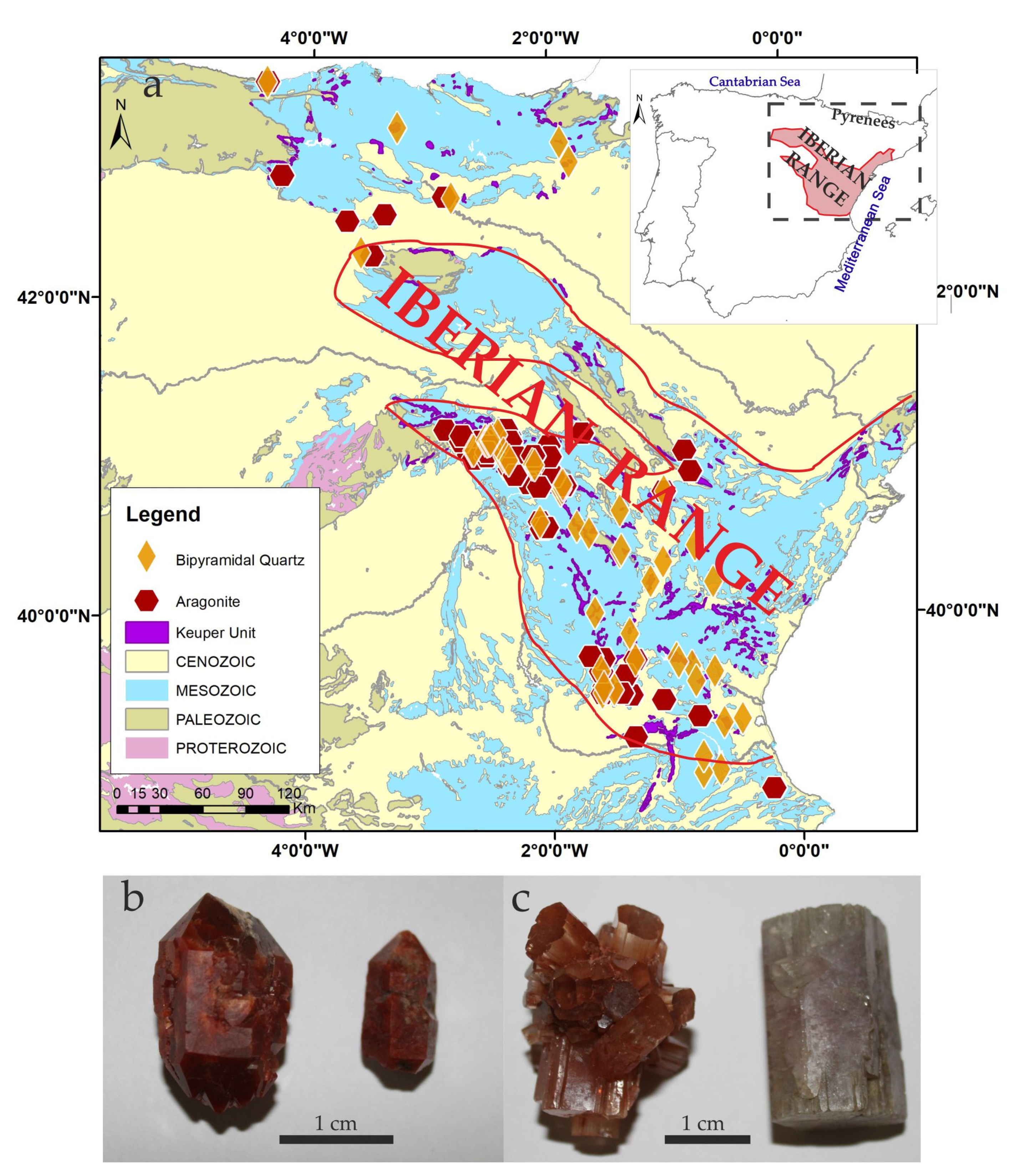

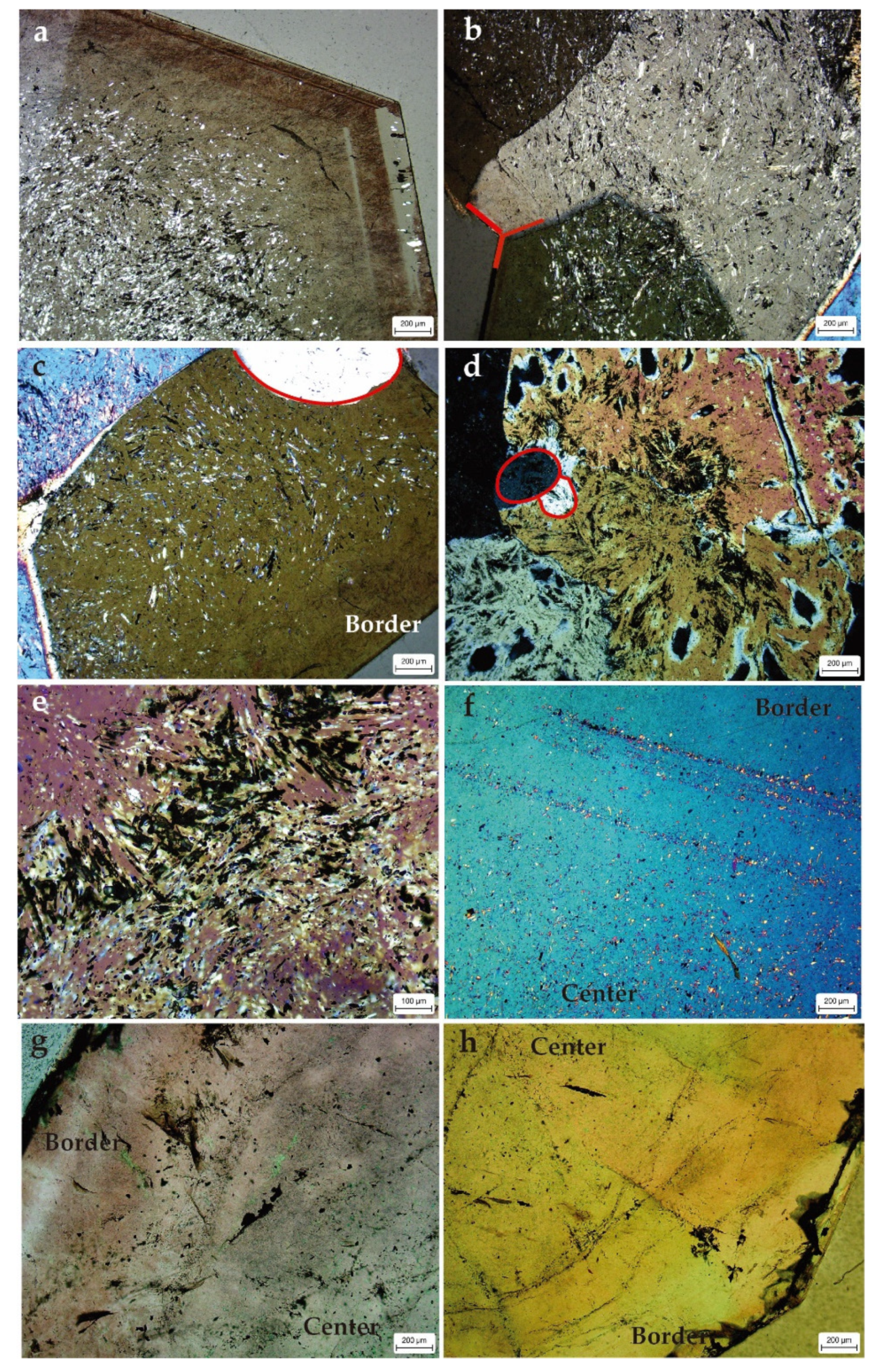
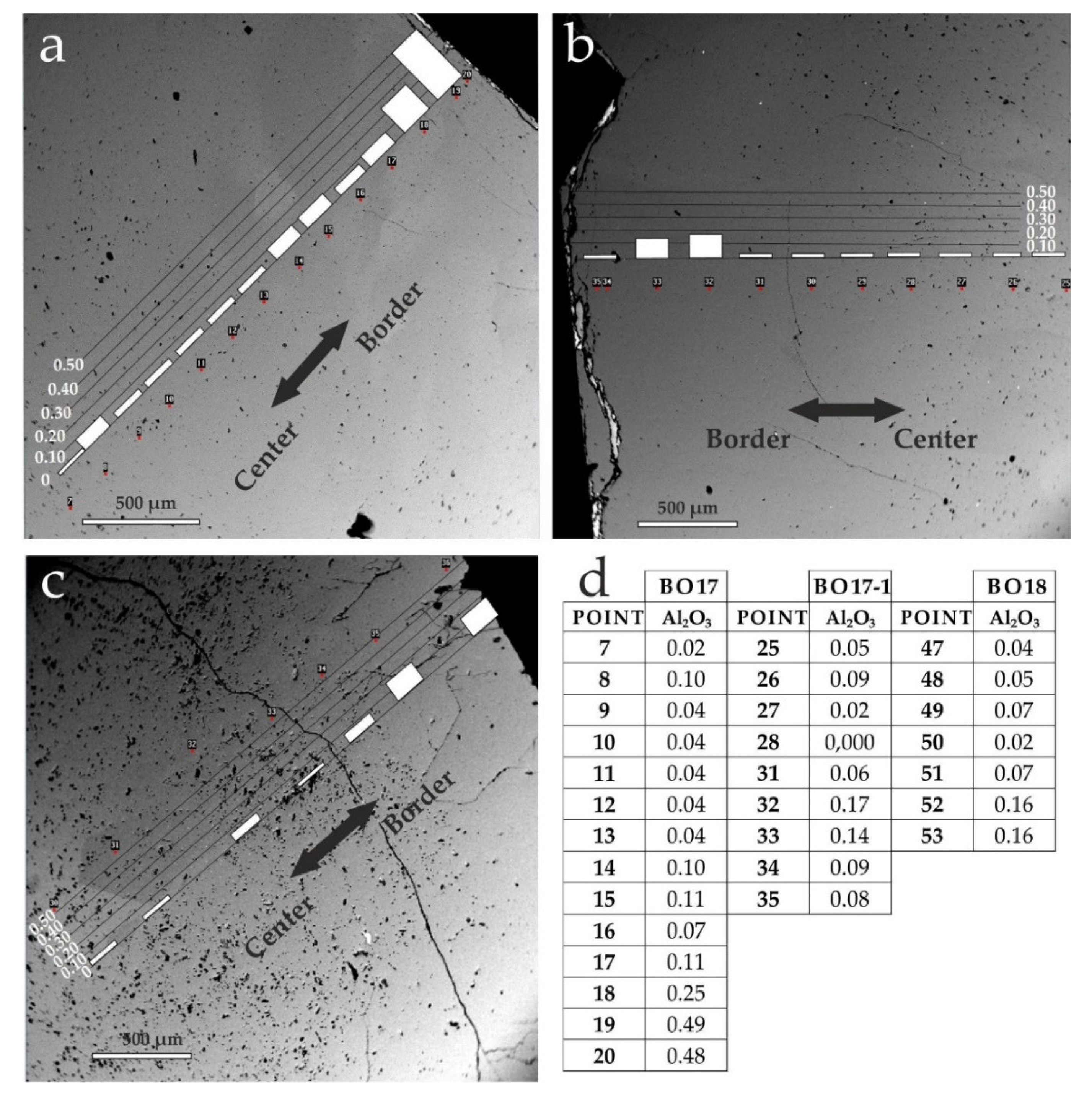
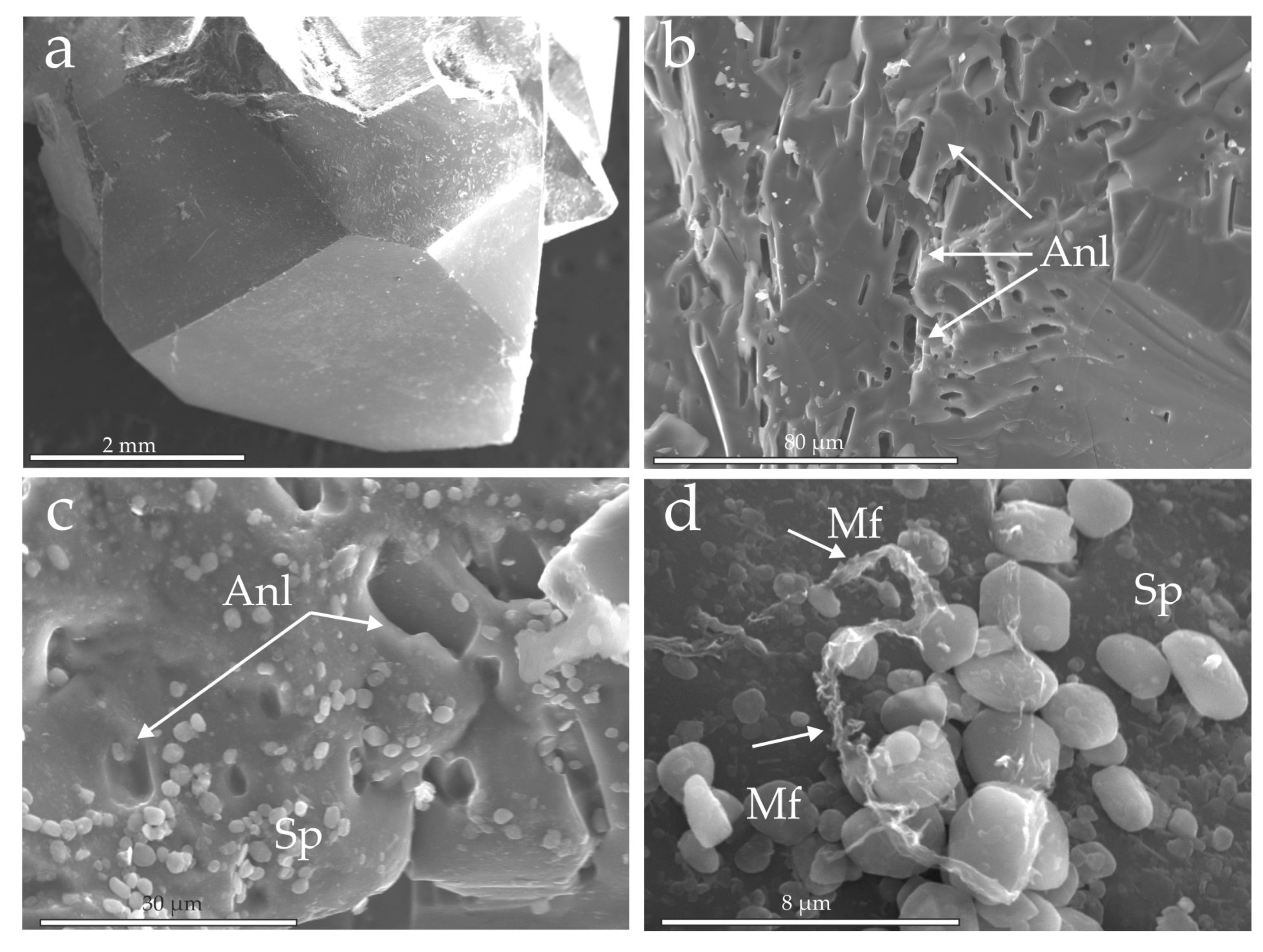
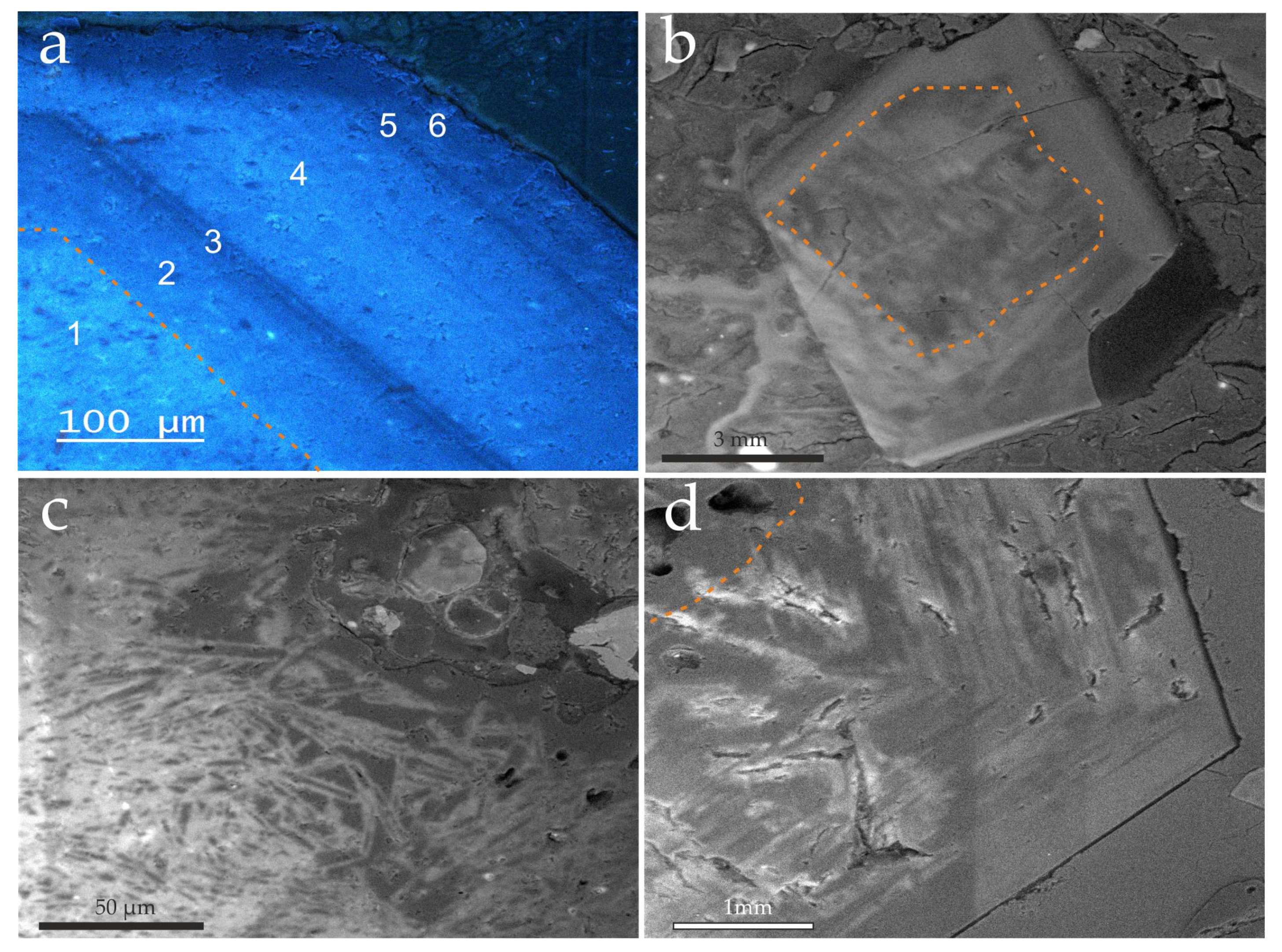

| Point | SiO2 | Al2O3 | FeO | MnO | MgO | CaO | Na2O | K2O | TiO2 | SO3 | BaO | ||
|---|---|---|---|---|---|---|---|---|---|---|---|---|---|
| BO17 | 1 | 99.52 | 0.29 | 0.12 | 0 | 0.01 | 0 | 0 | 0.02 | 0.01 | 0.03 | 0 | |
| BO17 | 2 | 99.67 | 0.24 | 0.04 | 0 | 0 | 0.01 | 0 | 0.01 | 0 | 0.01 | 0.02 | |
| BO17 | 3 | 99.72 | 0.27 | 0.01 | 0 | 0 | 0 | 0 | 0 | 0 | 0 | 0 | |
| BO17 | 4 | 99.78 | 0.05 | 0 | 0.06 | 0.02 | 0 | 0 | 0.02 | 0 | 0 | 0.07 | |
| BO17 | 5 | 99.92 | 0 | 0 | 0 | 0 | 0 | 0 | 0.02 | 0.01 | 0.04 | 0.01 | |
| BO17 | 6 | 99.83 | 0.02 | 0 | 0.02 | 0 | 0.03 | 0 | 0.01 | 0 | 0.01 | 0.08 | |
| BO17 | 7 | 99.89 | 0.02 | 0 | 0.01 | 0.01 | 0.03 | 0 | 0.01 | 0.02 | 0.01 | 0 | |
| BO17 | 8 | 99.68 | 0.10 | 0.07 | 0 | 0 | 0.03 | 0 | 0 | 0.03 | 0 | 0.09 | |
| BO17 | 9 | 99.85 | 0.04 | 0.03 | 0.03 | 0 | 0 | 0.02 | 0.01 | 0 | 0.02 | 0 | |
| BO17 | 10 | 99.84 | 0.04 | 0.02 | 0 | 0.01 | 0.01 | 0.01 | 0.01 | 0 | 0.03 | 0.03 | |
| BO17 | 11 | 99.88 | 0.04 | 0 | 0 | 0 | 0.03 | 0.01 | 0.02 | 0.01 | 0.01 | 0 | |
| BO17 | 12 | 99.78 | 0.04 | 0.05 | 0 | 0 | 0 | 0.01 | 0.01 | 0.01 | 0 | 0.10 | |
| BO17 | 13 | 99.89 | 0.04 | 0.03 | 0 | 0 | 0 | 0.01 | 0 | 0.02 | 0.01 | 0 | |
| BO17 | 14 | 99.8 | 0.10 | 0.02 | 0 | 0.01 | 0.01 | 0 | 0.02 | 0.02 | 0.02 | 0 | |
| BO17 | 15 | 99.8 | 0.11 | 0.01 | 0.02 | 0 | 0 | 0.01 | 0 | 0 | 0 | 0.05 | |
| BO17 | 16 | 99.87 | 0.07 | 0 | 0 | 0 | 0.01 | 0 | 0 | 0 | 0 | 0.05 | |
| BO17 | 17 | 99.74 | 0.11 | 0.02 | 0 | 0.02 | 0 | 0.01 | 0 | 0.01 | 0.04 | 0.05 | |
| BO17 | 18 | 99.58 | 0.25 | 0.05 | 0.03 | 0.01 | 0.02 | 0 | 0.01 | 0 | 0.01 | 0.04 | |
| BO17 | 19 | 99.5 | 0.49 | 0 | 0 | 0.01 | 0 | 0 | 0 | 0 | 0 | 0 | |
| BO17 | 20 | 99.4 | 0.48 | 0.07 | 0 | 0 | 0.02 | 0 | 0 | 0 | 0 | 0.03 | |
| BO17-1 | 25 | 99.9 | 0.05 | 0.01 | 0 | 0.01 | 0.02 | 0 | 0.01 | 0 | 0 | 0 | |
| BO17-1 | 26 | 99.81 | 0.09 | 0.01 | 0 | 0 | 0.01 | 0.02 | 0.01 | 0 | 0 | 0.05 | |
| BO17-1 | 27 | 99.92 | 0.02 | 0.03 | 0 | 0 | 0 | 0 | 0 | 0.03 | 0 | 0 | |
| BO17-1 | 28 | 99.88 | 0 | 0.05 | 0.03 | 0 | 0 | 0 | 0 | 0 | 0 | 0.04 | |
| BO17-1 | 31 | 99.84 | 0.06 | 0 | 0 | 0 | 0.01 | 0 | 0 | 0 | 0.02 | 0.07 | |
| BO17-1 | 32 | 99.67 | 0.17 | 0 | 0 | 0.01 | 0 | 0.02 | 0.01 | 0 | 0 | 0.12 | |
| BO17-1 | 33 | 99.7 | 0.14 | 0 | 0 | 0 | 0 | 0 | 0 | 0.01 | 0 | 0.15 | |
| BO17-1 | 34 | 99.82 | 0.09 | 0.04 | 0.01 | 0 | 0.01 | 0.01 | 0 | 0.02 | 0 | 0 | |
| BO17-1 | 35 | 99.87 | 0.08 | 0 | 0 | 0.03 | 0 | 0 | 0.01 | 0.01 | 0 | 0 | |
| BO15 | 36 | 99.78 | 0.07 | 0.06 | 0 | 0 | 0.01 | 0.01 | 0 | 0 | 0 | 0.06 | |
| BO15 | 37 | 99.55 | 0.15 | 0.06 | 0 | 0.16 | 0.03 | 0 | 0.01 | 0.01 | 0 | 0.02 | |
| BO15 | 38 | 99.85 | 0.04 | 0.07 | 0.01 | 0 | 0 | 0 | 0.02 | 0 | 0 | 0 | |
| BO15 | 39 | 99.69 | 0.02 | 0.14 | 0 | 0 | 0.01 | 0.01 | 0.02 | 0.03 | 0.02 | 0.05 | |
| BO15 | 40 | 99.84 | 0.10 | 0.01 | 0 | 0.01 | 0 | 0.01 | 0.02 | 0 | 0 | 0.01 | |
| BO15 | 41 | 99.89 | 0 | 0 | 0 | 0 | 0 | 0 | 0.02 | 0 | 0.02 | 0.06 | |
| BO15 | 42 | 99.77 | 0.11 | 0.04 | 0 | 0 | 0.01 | 0 | 0.01 | 0 | 0 | 0.06 | |
| BO15 | 43 | 99.71 | 0.08 | 0.02 | 0 | 0.01 | 0.02 | 0.01 | 0 | 0 | 0 | 0.15 | |
| BO15 | 44 | 99.72 | 0.09 | 0.04 | 0.02 | 0 | 0.01 | 0 | 0 | 0 | 0 | 0.11 | |
| BO15 | 45 | 99.68 | 0.15 | 0.06 | 0 | 0.01 | 0.02 | 0 | 0.01 | 0 | 0.03 | 0.03 | |
| BO15 | 46 | 99.82 | 0.03 | 0.11 | 0.02 | 0 | 0 | 0 | 0.01 | 0 | 0.01 | 0 | |
| BO18 | 47 | 99.7 | 0.04 | 0.07 | 0 | 0 | 0 | 0 | 0.10 | 0 | 0.09 | 0 | |
| BO18 | 48 | 99.81 | 0.05 | 0.06 | 0 | 0.03 | 0 | 0 | 0.02 | 0.02 | 0.01 | 0 | |
| BO18 | 49 | 99.85 | 0.07 | 0.03 | 0 | 0 | 0 | 0 | 0.01 | 0.04 | 0 | 0 | |
| BO18 | 50 | 99.77 | 0.02 | 0.07 | 0 | 0 | 0 | 0.01 | 0 | 0.01 | 0.02 | 0.10 | |
| BO18 | 51 | 99.8 | 0.07 | 0 | 0.02 | 0.02 | 0 | 0 | 0.01 | 0.04 | 0.04 | 0 | |
| BO18 | 52 | 99.68 | 0.16 | 0.12 | 0 | 0 | 0.02 | 0.02 | 0 | 0 | 0 | 0 | |
| BO18 | 53 | 99.73 | 0.16 | 0.05 | 0 | 0 | 0.02 | 0.02 | 0.01 | 0 | 0.01 | 0 | |
| Mean | 99.77 | 0.1 | 0.04 | 0.01 | 0.01 | 0.01 | 0 | 0.01 | 0.01 | 0.01 | 0.04 | ||
| Std. Dev. | 0.12 | 0.11 | 0.04 | 0.01 | 0.02 | 0.01 | 0.01 | 0.02 | 0.01 | 0.02 | 0.04 | ||
© 2020 by the authors. Licensee MDPI, Basel, Switzerland. This article is an open access article distributed under the terms and conditions of the Creative Commons Attribution (CC BY) license (http://creativecommons.org/licenses/by/4.0/).
Share and Cite
Herrero, M.J.; Marfil, R.; Escavy, J.I.; Al-Aasm, I.; Scherer, M. Diagenetic Origin of Bipyramidal Quartz and Hydrothermal Aragonites within the Upper Triassic Saline Succession of the Iberian Basin: Implications for Interpreting the Burial–Thermal Evolution of the Basin. Minerals 2020, 10, 177. https://doi.org/10.3390/min10020177
Herrero MJ, Marfil R, Escavy JI, Al-Aasm I, Scherer M. Diagenetic Origin of Bipyramidal Quartz and Hydrothermal Aragonites within the Upper Triassic Saline Succession of the Iberian Basin: Implications for Interpreting the Burial–Thermal Evolution of the Basin. Minerals. 2020; 10(2):177. https://doi.org/10.3390/min10020177
Chicago/Turabian StyleHerrero, María J., Rafaela Marfil, Jose I. Escavy, Ihsan Al-Aasm, and Michael Scherer. 2020. "Diagenetic Origin of Bipyramidal Quartz and Hydrothermal Aragonites within the Upper Triassic Saline Succession of the Iberian Basin: Implications for Interpreting the Burial–Thermal Evolution of the Basin" Minerals 10, no. 2: 177. https://doi.org/10.3390/min10020177
APA StyleHerrero, M. J., Marfil, R., Escavy, J. I., Al-Aasm, I., & Scherer, M. (2020). Diagenetic Origin of Bipyramidal Quartz and Hydrothermal Aragonites within the Upper Triassic Saline Succession of the Iberian Basin: Implications for Interpreting the Burial–Thermal Evolution of the Basin. Minerals, 10(2), 177. https://doi.org/10.3390/min10020177







